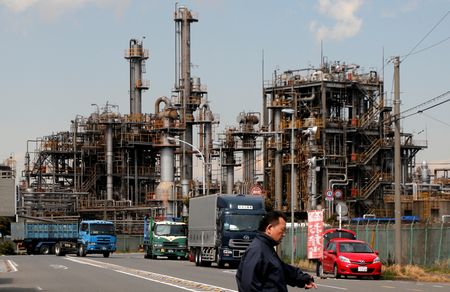
By Jamie McGeever
(Reuters) – A look at the day ahead in Asian markets from Jamie McGeever.
Flash purchasing manager index reports from Japan and Australia on Tuesday will give an insight into how two of Asia’s biggest economies are performing, as trading volumes return to normal after U.S. markets were closed for Presidents Day.
The U.S. market holiday on Monday allowed the spotlight to shift to geopolitics – President Joe Biden made an unannounced visit to Kyiv ahead of the one-year anniversary of Russia’s invasion of Ukraine, U.S. Secretary of State Antony Blinken warned China of consequences should it provide material support to Russia and North Korea fired more missiles.
Plenty to chew on and, along with the startling upward repricing of U.S. interest rate expectations, perhaps more likely to fray investors’ nerves than soothe them. Or not – global stocks ticked higher on Monday and Chinese stocks had their best day since November on economic reopening optimism, with the blue-chip CSI300 Index surging 2.5%.
The economic calendar and market trading grind back into gear on Tuesday, kicking off in Asia with the flash Aussie and Japanese PMIs for February.
Graphic: Japan composite PMI vs GDP – https://fingfx.thomsonreuters.com/gfx/mkt/dwpkdzgdkvm/JapanPMI.jpg
Manufacturing activity in Japan has contracted for three months in a row and service-sector activity has expanded for five months, meaning overall economic activity grew in January for the first time in three months.
This is an important week for Japan. Consumer price inflation figures on Friday are expected to show a rise in the annual rate to a new 41-year high above 4%, and incoming Bank of Japan Governor Kazuo Ueda testifies before parliament also on Friday.
Graphic: Australia manufacturing PMI – https://fingfx.thomsonreuters.com/gfx/mkt/zjvqjyqjapx/AUSPMI.png
The pace of growth in Australian manufacturing, meanwhile, has slowed for seven straight months and the sector is on the cusp of contracting for the first time since May 2020. Services and overall business activity as measured by the PMIs have been contracting for four months.
There appears to be little hope of relief on the interest rate front, however. Reserve Bank of Australia Governor Philip Lowe last week repeated his view that further rate rises in coming months are needed and said the pain was worth bearing to bring inflation down.
The monetary policy stance in Beijing is far less hawkish. The People’s Bank of China on Monday kept benchmark lending rates unchanged for a sixth month, leaving the one-year loan prime rate at 3.65% and the five-year rate at 4.30%. The economy seems to be rebounding from its zero-COVID restrictions, but there may be more monetary easing to come.
China’s government will announce key growth targets for the year at the National People’s Congress which is scheduled to begin on March 5. This may be a good time to deliver growth-boosting rate cuts or ramp up liquidity injections even more.
Here are three key developments that could provide more direction to markets on Tuesday:
– Japan flash PMIs (February)
– Australia flash PMIs (February)
– Reserve Bank of Australia policy meeting minutes
(By Jamie McGeever; Editing by Josie Kao)

